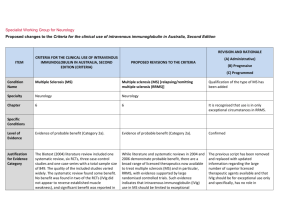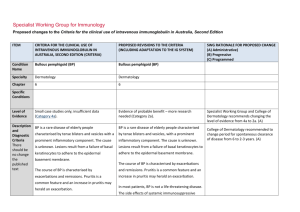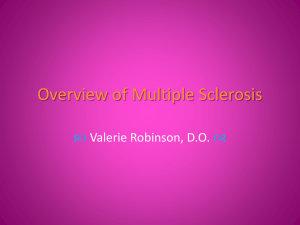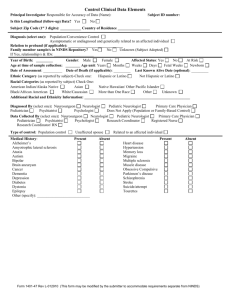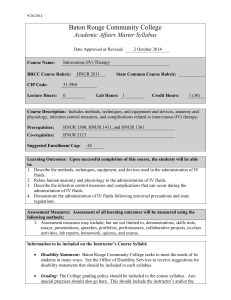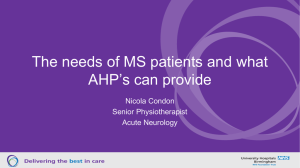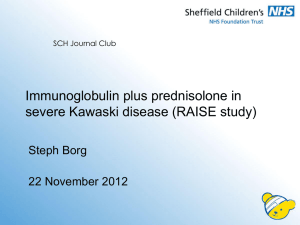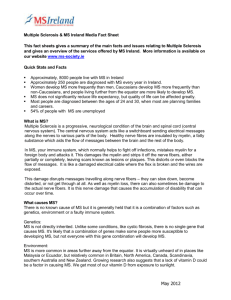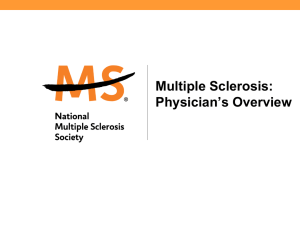relapsing-remitting-multiple
advertisement
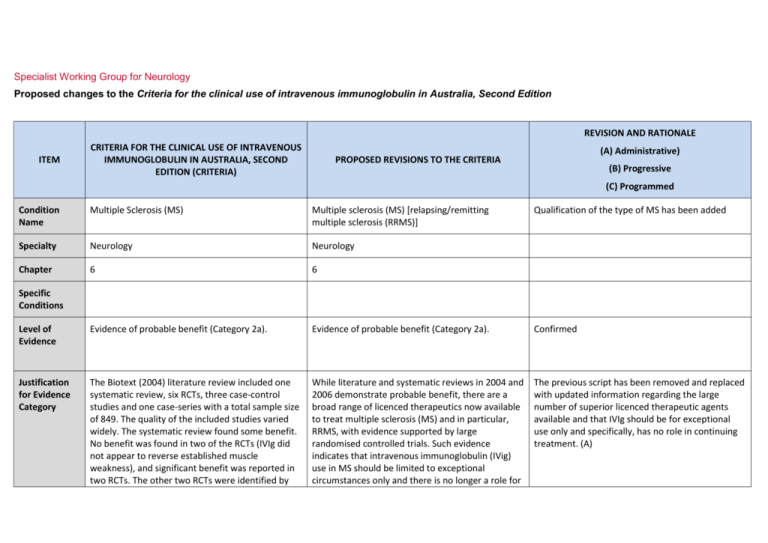
Specialist Working Group for Neurology Proposed changes to the Criteria for the clinical use of intravenous immunoglobulin in Australia, Second Edition REVISION AND RATIONALE ITEM CRITERIA FOR THE CLINICAL USE OF INTRAVENOUS IMMUNOGLOBULIN IN AUSTRALIA, SECOND EDITION (CRITERIA) (A) Administrative) PROPOSED REVISIONS TO THE CRITERIA (B) Progressive (C) Programmed Condition Name Multiple Sclerosis (MS) Multiple sclerosis (MS) [relapsing/remitting multiple sclerosis (RRMS)] Qualification of the type of MS has been added Specialty Neurology Neurology Chapter 6 6 Level of Evidence Evidence of probable benefit (Category 2a). Evidence of probable benefit (Category 2a). Confirmed Justification for Evidence Category The Biotext (2004) literature review included one systematic review, six RCTs, three case-control studies and one case-series with a total sample size of 849. The quality of the included studies varied widely. The systematic review found some benefit. No benefit was found in two of the RCTs (IVIg did not appear to reverse established muscle weakness), and significant benefit was reported in two RCTs. The other two RCTs were identified by While literature and systematic reviews in 2004 and 2006 demonstrate probable benefit, there are a broad range of licenced therapeutics now available to treat multiple sclerosis (MS) and in particular, RRMS, with evidence supported by large randomised controlled trials. Such evidence indicates that intravenous immunoglobulin (IVig) use in MS should be limited to exceptional circumstances only and there is no longer a role for The previous script has been removed and replaced with updated information regarding the large number of superior licenced therapeutic agents available and that IVIg should be for exceptional use only and specifically, has no role in continuing treatment. (A) Specific Conditions REVISION AND RATIONALE CRITERIA FOR THE CLINICAL USE OF INTRAVENOUS IMMUNOGLOBULIN IN AUSTRALIA, SECOND EDITION (CRITERIA) ITEM PROPOSED REVISIONS TO THE CRITERIA (A) Administrative) (B) Progressive (C) Programmed Biotext from the Cochrane register of trials, but no further information about the studies was obtained. The review by Frommer and Madronio (2006) included eight high-quality RCTs and one medium-quality double-blinded controlled trial with a total of 708 patients. These studies suggested that the occurrence of relapse may be reduced by IVIg at three years, but conclusive evidence in relation to the use of IVIg in reducing relapse rates and severity of relapse in established disease could not be demonstrated. IVIg treatment for the first year from onset of the first neurological event significantly lowered the incidence of second attacks and reduced disease activity as measured by MRI. IVIg in the continuing treatment of MS. IVIg may be indicated in treatment of relapses where there are severe disabling consequences of the attack (e.g. paraparesis or blindness). See Therapeutic approaches to disease modifying therapy for multiple sclerosis in adults: an Australian and New Zealand perspective: part 3 treatment practicalities and recommendations J Clin Neurosci. 2014 Nov;21(11):1857-65. IVIg administered in monthly pulses for up to two years appeared to reduce annual exacerbation rates in patients with RRMS and SPMS, but its effect on long-term disability was unclear. Description and Diagnostic Criteria MS is a chronic disorder of the central nervous system (CNS) characterised by a triad of inflammation, demyelination and gliosis. Lesions of MS, known as plaques, are typically disseminated in time and location throughout the brain and spinal cord. National Blood Authority MS is a chronic disorder of the central nervous system (CNS) characterised by a triad of inflammation, demyelination and gliosis. Lesions of MS, known as plaques, are typically disseminated in time and location throughout the brain and spinal cord. pg. 2 Diagnostic criteria have been revised and updated in line with an International Consensus conference of 2010. REVISION AND RATIONALE CRITERIA FOR THE CLINICAL USE OF INTRAVENOUS IMMUNOGLOBULIN IN AUSTRALIA, SECOND EDITION (CRITERIA) ITEM (A) Administrative) PROPOSED REVISIONS TO THE CRITERIA (B) Progressive (C) Programmed Four clinical types of MS have been described: relapsing/remitting MS (RRMS), primary progressive MS (PPMS), secondary progressive MS (SPMS), and progressive/relapsing MS (PRMS). Four clinical types of MS have been described: relapsing/remitting MS (RRMS), primary progressive MS (PPMS), secondary progressive MS (SPMS), and progressive/relapsing MS (PRMS). Diagnosis requires two or more episodes of symptoms and two or more signs that reflect pathology in anatomically non-contiguous white matter tracts of the CNS. Symptoms must last >24 hours and occur as separate episodes at least one month apart. At least one of the two signs must be present on neurological examination, while the other may be detected by paraclinical tests such as intrathecal IgG (oligoclonal bands and visual evoked potentials). New evidence and consensus in 2010 has led to further revision of the McDonald Criteria for diagnosis of multiple sclerosis. The use of imaging for demonstration of dissemination of central nervous system lesions in space and time is defined. The 2010 revisions simplify the diagnostic criteria, maintain their diagnostic sensitivity and specificity and support earlier diagnosis and more uniform and widespread use. (Ann Neurol 2011 Feb; 69(2): 292-302. Diagnosis is required Clinically definite Yes neurologist RRMS as defined by McDonald et al (2001) criteria By which specialty Yes - Neurologist Diagnosis must be verified Diagnosis must be No confirmed by a neurologist By which specialty no Exclusion Criteria Primary progressive MS. Primary progressive MS. National Blood Authority Diagnosis to be made by a neurologist according to McDonald 2010 (A) Unchanged pg. 3 REVISION AND RATIONALE CRITERIA FOR THE CLINICAL USE OF INTRAVENOUS IMMUNOGLOBULIN IN AUSTRALIA, SECOND EDITION (CRITERIA) ITEM PROPOSED REVISIONS TO THE CRITERIA (A) Administrative) (B) Progressive (C) Programmed Progressive phase of MS without relapses. Indications Progressive phase of MS without relapses. Short-term therapy in patients with clinically definite relapsing remitting MS in the following circumstances: Severe relapse of clinically definite RRMS with no response to high-dose methylprednisolone or where methylprednisolone is contraindicated. Pregnancy and the immediate post-partum period when other immunomodulation is contraindicated; Prevention of MS relapse where other Therapeutic Goods Administration (TGA) licensed therapies are inappropriate or are contraindicated. Young patients with severe relapsing remitting disease in whom other therapies have failed; Severe relapse with no response to high-dose methylprednisolone. Qualifying Criteria The 13-14 IVIg usage data shows that fewer than 5 pregnant MS patients required IVIg and 25 patients received IVIg under the “Young” indication -18 patients received IVIg for the third indication. A new indication was developed to cover instances where TGA approved medications were unavailable or unsafe. This might now be used for pregnancy or young patients as this indication would equally apply in those unusual circumstances. Clinically definite RRMS as defined by McDonald et al (2001) criteria and confirmed by a neurologist with one of the following indications: Severe relapse of clinically definite RRMS with no response to high-dose methylprednisolone or where methylprednisolone is contraindicated. Pregnancy and immediate post partum period Severe relapse of clinically definite RRMS proven by brain or spinal cord MRI scan and at least two National Blood Authority SWG confirmed that the first 2 indications are not required and should be deleted. These indications are no longer an emerging role. IVig should now only be used in exceptional circumstances - there are now better treatments available that are more effective and can be used effectively in pregnancy (eg Tysabri). The indication where MP is contraindicated (e.g. previous psychotic episode on MP) should be retained. pg. 4 Qualifying criteria have been aligned with those currently used for licenced TGA therapeutics (high cost drugs). REVISION AND RATIONALE ITEM CRITERIA FOR THE CLINICAL USE OF INTRAVENOUS IMMUNOGLOBULIN IN AUSTRALIA, SECOND EDITION (CRITERIA) PROPOSED REVISIONS TO THE CRITERIA (A) Administrative) (B) Progressive (C) Programmed when other immunomodulation is contraindicated; relapses in the previous two years AND OR Young patients with severe relapsing remitting disease in whom other therapies have failed; Patient has not responded to a course of high-dose methylprednisolone treatment OR Methylprednisolone treatment is contraindicated. OR Severe relapse with no response to high-dose methylprednisolone. Application for IVIg use for these indications will be considered on a case-by-case basis and may be reviewed by an expert neurologist in MS in each state Note: There are numerous immunomodulatory therapies available for multiple sclerosis. IVIg is not available for routine ongoing treatment for patients with MS. The expanded disability status scale is used to measure response at review. Prevention of MS relapse where other Therapeutic Goods Administration (TGA) licensed therapies are inappropriate or are contraindicated. Patients with clinically definite RRMS proven by brain or spinal cord MRI scan and at least two relapses in the previous two years AND The patient remains ambulant as measured by the Expanded Disability Status Scale to a maximum value of 6.5 points. AND Disease activity is resistant to all other therapies or therapies are unavailable or are contra-indicated. National Blood Authority pg. 5 Alternative therapies that must have been tried or are unavailable or contra-indicated include: Methylprednisolone, Plasmapheresis Exchange, Fingolimod (Gilenya), Copoxone (glatiramer acetate), Interferon beta (Avonex, Betaferon, Rebif) Dimethyl fumerate (Tecfidera), Natalizumab (Tysabri), Teriflunomide (Aubagio), and Alemtuzumab (Lemtrada). REVISION AND RATIONALE CRITERIA FOR THE CLINICAL USE OF INTRAVENOUS IMMUNOGLOBULIN IN AUSTRALIA, SECOND EDITION (CRITERIA) ITEM PROPOSED REVISIONS TO THE CRITERIA (A) Administrative) (B) Progressive (C) Programmed Six-monthly review by a neurologist is required. Review Criteria Objective evidence of improvement in relapse rate in comparison to pre-treatment levels. Severe relapse of clinically definite RRMS with no response to high-dose methylprednisolone or where methylprednisolone is contraindicated. No review required – one off therapy o expanded disability status scale; Prevention of MS relapse where other Therapeutic Goods Administration (TGA) licensed therapies are inappropriate or are contraindicated. o MS functional scores; Six-monthly review by a neurologist is required. o other functional measures. Other measures that may be useful include: Review criteria for assessing the effectiveness of IVIg treatment includes evidence of improvement in relapse rate in comparison to pre-treatment levels. After a maximum of 12 months treatment, patients should be re-assessed as to whether a TGA-licensed agent is now the more appropriate treatment. A new authorisation request will be required for any subsequent course (after 12 months) as appropriate. National Blood Authority pg. 6 Reviews are to be conducted at 6 months to prove response and a maximum treatment period has been set to 12 months. SWG advised that a new authorisation request should be made for each subsequent course (after 12 months) as appropriate. REVISION AND RATIONALE ITEM CRITERIA FOR THE CLINICAL USE OF INTRAVENOUS IMMUNOGLOBULIN IN AUSTRALIA, SECOND EDITION (CRITERIA) PROPOSED REVISIONS TO THE CRITERIA (A) Administrative) (B) Progressive (C) Programmed On review of the initial authorisation period Patient has not demonstrated evidence of RRMS disease progression while on Ig treatment as measured by the Expanded Disability Status Scale to a value equal to or less than the qualifying score. AND Other therapies remain ineffective or unavailable and a valid reason to continue Ig treatment is provided. Note: There are numerous immunomodulatory therapies available for multiple sclerosis. IVIg is not available for routine ongoing treatment for patients with MS. Induction: 1–2 g/kg in 2 to 5 divided doses. Dose Maintenance dose for indications 1 and 2 above: 0.4–1 g/kg, 4 to 6 weekly. Aim for minimum dose to maintain optimal functional status. Refer to the current product information sheet for further information. The aim should be to use the lowest dose possible that achieves the appropriate clinical outcome for each patient. Severe relapse of clinically definite RRMS with no response to high-dose methylprednisolone or where methylprednisolone is contraindicated. One off dosing only allowed for the first indication. Induction: 1–2 g/kg in 2 to 5 divided doses The aim should be to use the lowest dose possible that achieves the appropriate clinical outcome for each patient. Refer to the current product information sheet for National Blood Authority pg. 7 REVISION AND RATIONALE ITEM CRITERIA FOR THE CLINICAL USE OF INTRAVENOUS IMMUNOGLOBULIN IN AUSTRALIA, SECOND EDITION (CRITERIA) PROPOSED REVISIONS TO THE CRITERIA (A) Administrative) (B) Progressive (C) Programmed further information. Note: There are numerous immunomodulatory therapies available for multiple sclerosis. IVIg is not available for routine ongoing treatment for patients with MS. Patients should be re-assessed as to whether a TGA-licensed agent is now the more appropriate treatment. Prevention of MS relapse where other Therapeutic Goods Administration (TGA) licensed therapies are inappropriate or are contraindicated. Induction: 1–2 g/kg in 2 to 5 divided doses Maintenance 0.4 g – 1 g/Kg, 4–6 weekly. The aim should be to use the lowest dose possible that achieves the appropriate clinical outcome for each patient. Refer to the current product information sheet for further information. Note: There are numerous immunomodulatory therapies available for multiple sclerosis. IVIg is not National Blood Authority pg. 8 Dosing unchanged however a maximum treatment period limited to 12 months. After that time, a patient would be required to requalify. REVISION AND RATIONALE CRITERIA FOR THE CLINICAL USE OF INTRAVENOUS IMMUNOGLOBULIN IN AUSTRALIA, SECOND EDITION (CRITERIA) ITEM PROPOSED REVISIONS TO THE CRITERIA (A) Administrative) (B) Progressive (C) Programmed available for routine ongoing treatment for patients with MS. Patients should be re-assessed as to whether a TGA-licensed agent is now the more appropriate treatment. POTENTIAL OPERATIONAL IMPACT There is not expected to be any significant impact operationally as very little Ig is used for this condition and patients will still be able to access in exceptional circumstances. POTENTIAL IMPACT ON DEMAND Number of patient in 2013-14 No impact likely on demand. Usage represented less than 1%. Existing patients: Pregnancy <5 Severe relapsing adults 18 Young severe relapsing 25 Usage 2013-14 <1% POTENTIAL COST BIBLIOGRAPHY Achiron, A, Kishner, I, Sarova-Pinhas, I, et al 2004, ‘Intravenous immunoglobulin treatment following the first demyelinating event suggestive of multiple sclerosis: a randomized, double-blind, placebo-controlled trial’, Archives of Neurology, vol. 61, no. 10, pp. 1515–20. National Blood Authority pg. 9 Association of British Neurologists 2005, Guidelines for the use of intravenous immunoglobulin in neurological diseases, The Association, London. Available from: www.theabn.org/abn/ userfiles/file/IVIg-guidelines-final-July05.pdf [cited 7 Dec 2007] Barak, Y, Gabbay, U, Gilad, R, et al 1999, ‘Neuropsychiatric assessment as a secondary outcome measure in a multiple sclerosis intravenous immunoglobulin trial’, International Journal of Psychiatry in Clinical Practice, vol. 3, no. 1, pp. 31–4. Clin, J, 2014, 'Therapeutic approaches to disease modifying therapy for multiple sclerosis i nhjadults: an Australian and New Zealand perspective: part 3 treatment practicalities and recommendations', Neurosci. Nov 21 (11), pp 1857-65. Deisenhammer, F, Fazekas, F, Strasser-Fuchs, S, et al 1999, ‘Intravenous immunoglobulins in multiple sclerosis: results of the Austrian Immunoglobulin in Multiple Sclerosis (AIMS) trial’, Infusionstherapie und Transfusionsmedizin, vol. 26, pp. 42–7. Fazekas, F, Sorensen, PS, Filippi, M, et al 2005, ‘MRI results from the European Study on Intravenous Immunoglobulin in Secondary Progressive Multiple Sclerosis (ESIMS)’, Multiple Sclerosis, vol. 11, no. 4, pp. 433–40. Filippi, M, Rocca, MA, Pagani, E, et al 2004, ‘European study on intravenous immunoglobulin in multiple sclerosis: results of magnetization transfer magnetic resonance imaging analysis’, Archives of Neurology, vol. 61, no. 9, pp. 1409–12. Goodin, DS, Frohman, EM, Garmany, GP, et al 2002, ‘Disease modifying therapies in multiple sclerosis: Subcommittee of the American Academy of Neurology and the MS Council for Clinical Practice Guidelines’, Neurology, vol. 58, pp. 169–78. Gray, OM, McDonnell, GV & Forbes, RB 2004, ‘Intravenous immunoglobulins for multiple sclerosis (Cochrane Review)’, in The Cochrane Library, Issue 2, John Wiley & Sons, Ltd, Chichester, UK. Lewanska, M, Siger-Zajdel, M & Selmaj, K 2002, ‘No difference in efficacy of two different doses of intravenous immunoglobulins in MS: clinical and MRI assessment’, European Journal of Neurology, vol. 9, no. 6, pp. 565–72. McDonald, WI, Compston, A, Edan, G, et al 2001, ‘Recommended diagnostic criteria for multiple sclerosis: guidelines from the International Panel on the diagnosis of multiple sclerosis’, Annals of Neurology, vol. 50, no. 1, pp. 121–7. Noseworthy, JH, O’Brien, PC, Weinshenker, BG, et al 2000, ‘IV immunoglobulin does not reverse established weakness in MS’, Neurology, vol. 55, no. 8, pp. 1135–43. Orange, JS, Hossny, EM, Weiler, CR, et al 2006, ‘Use of intravenous immunoglobulin in human disease: A review of primary evidence by members of the Primary Immunodeficiency Committee of the American Academy of Allergy, Asthma and Immunology’, Journal of Allergy and Clinical Immunology, vol. 117, no. 4, pp. S525–53. Oztekin, N & Oztekin MF 1998, ‘Intravenous immunoglobulin treatment in relapsing-remitting multiple sclerosis: a double blind cross over study’, Multiple Sclerosis, vol. 4, p. 391. Roed, HG, Langkilde, A, Sellebjerg, F, et al 2005, ‘A double-blind randomised trial of IV immunoglobulin treatment in acute optic neuritis’, Neurology, vol. 64, pp. 804–10. Sacher, RA & IVIg Advisory Panel 2001, ‘Intravenous immunoglobulin consensus statement’, Journal of Allergy and Clinical Immunology, vol. 108, no. 4, pp. S139–46. Soelberg-Sorensen, P, Haas, J, Sellebjerg, F, et al 2004, ‘IV immunoglobulins as add-on treatment to methylprednisolone for acute relapses in MS’, Neurology, vol. 63, no. 11, pp. 2008–33. Soelberg-Sorensen, P, Wanscher, B, Schreiber, K, et al 1997, ‘Effect of intravenous immunoglobulin on gadolinium enhancing lesions on MRI in multiple sclerosis (MS): final results of a double-blind cross-over trial,’ Multiple Sclerosis, vol. 3, suppl., p. 268. Sorensen, PS, Fazekas, F & Lee, M 2002, ‘Intravenous immunoglobulin G for the treatment of relapsing-remitting multiple sclerosis: a meta-analysis’, European Journal of Neurology, vol. 9, no. 6, pp. 557–63. Stangel, M, Boegner, F, Klatt, CH, et al 2000, ‘Placebo controlled pilot trial to study the remyelinating potential of intravenous immunoglobulins in multiple sclerosis’, Journal of Neurology, Neurosurgery and Psychiatry, vol. 68, no. 1, pp. 89–92. National Blood Authority pg. 10 Strasser-Fuchs, S, Fazekas, F, Deisenhammer, F, et al 2000, ‘The Austrian Immunoglobulin in MS (AIMS) study: final analysis’, Multiple Sclerosis, vol. 6, suppl. 2, pp. S9–13. Visser, LH, Beekman, R, Tijssen, CC, et al 2004, ‘A randomized, double-blind, placebo-controlled pilot study of i.v. immune globulins in combination with IV methylprednisolone in the treatment of relapses in patients with MS’, Multiple Sclerosis, vol. 10, no. 1, pp. 89–91. END OF DOCUMENT National Blood Authority pg. 11
